Swinburne PSY10004 Lab Report: Learning Strategies and Performance
VerifiedAdded on 2023/06/04
|15
|3717
|222
Report
AI Summary
This lab report, based on a study involving 239 psychology students, investigates the effectiveness of distributed practice compared to massed practice learning strategies. The study, conducted in two parts, involved participants engaging in either distributed or massed study sessions followed by fill-in-the-blank and multiple-choice tests. The results indicated that distributed practice led to higher overall performance, supporting the hypothesis that spaced learning enhances memory retention. The report details the methodology, participant demographics, materials, and procedures, providing a comprehensive analysis of the learning techniques' impact on test scores and performance. The study also found that massed practice performed better in multiple-choice tests. The study also discusses the spacing effect and its importance in human learning, concluding that distributed practice is more beneficial for long-term retention and retrieval of knowledge.
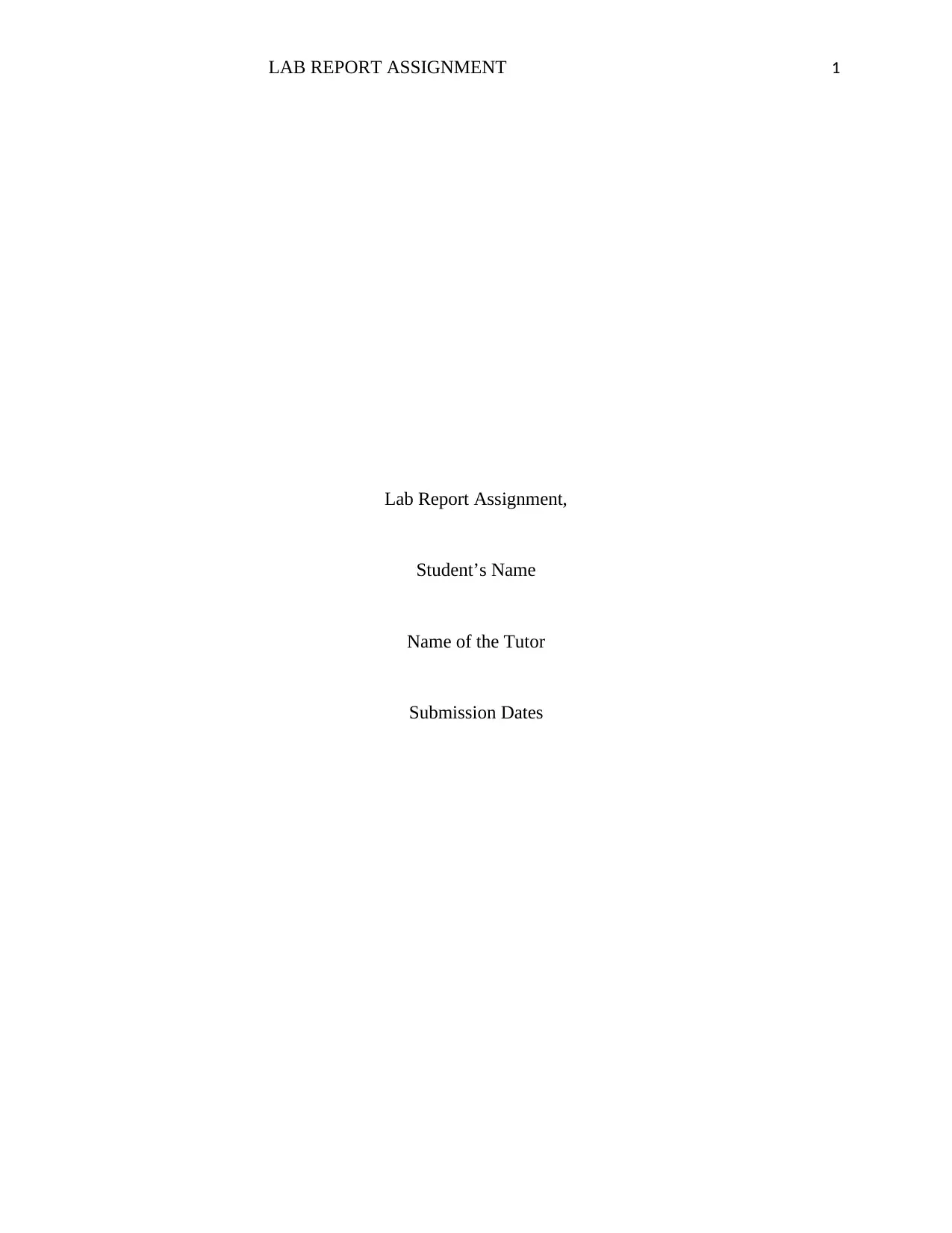
LAB REPORT ASSIGNMENT 1
Lab Report Assignment,
Student’s Name
Name of the Tutor
Submission Dates
Lab Report Assignment,
Student’s Name
Name of the Tutor
Submission Dates
Paraphrase This Document
Need a fresh take? Get an instant paraphrase of this document with our AI Paraphraser
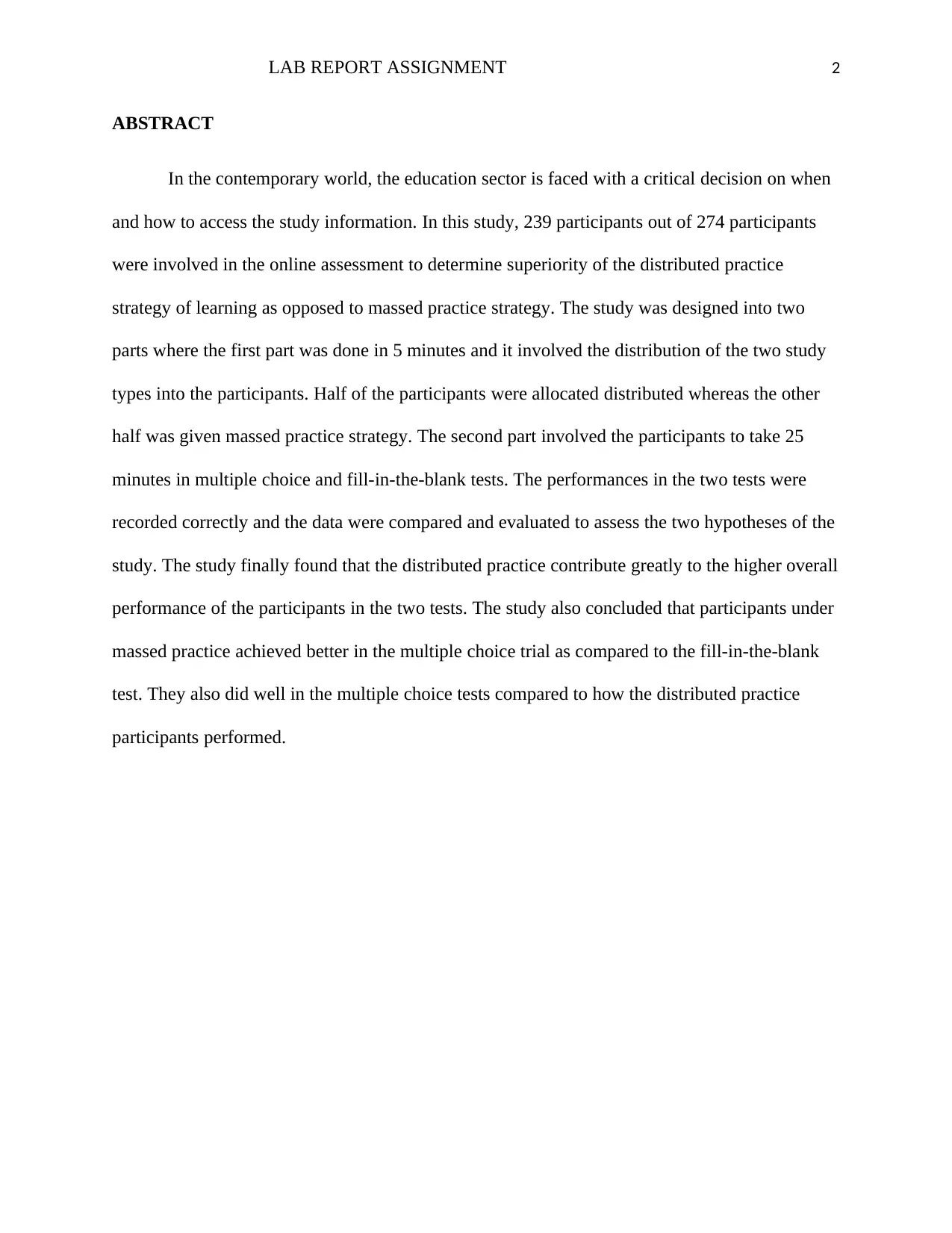
LAB REPORT ASSIGNMENT 2
ABSTRACT
In the contemporary world, the education sector is faced with a critical decision on when
and how to access the study information. In this study, 239 participants out of 274 participants
were involved in the online assessment to determine superiority of the distributed practice
strategy of learning as opposed to massed practice strategy. The study was designed into two
parts where the first part was done in 5 minutes and it involved the distribution of the two study
types into the participants. Half of the participants were allocated distributed whereas the other
half was given massed practice strategy. The second part involved the participants to take 25
minutes in multiple choice and fill-in-the-blank tests. The performances in the two tests were
recorded correctly and the data were compared and evaluated to assess the two hypotheses of the
study. The study finally found that the distributed practice contribute greatly to the higher overall
performance of the participants in the two tests. The study also concluded that participants under
massed practice achieved better in the multiple choice trial as compared to the fill-in-the-blank
test. They also did well in the multiple choice tests compared to how the distributed practice
participants performed.
ABSTRACT
In the contemporary world, the education sector is faced with a critical decision on when
and how to access the study information. In this study, 239 participants out of 274 participants
were involved in the online assessment to determine superiority of the distributed practice
strategy of learning as opposed to massed practice strategy. The study was designed into two
parts where the first part was done in 5 minutes and it involved the distribution of the two study
types into the participants. Half of the participants were allocated distributed whereas the other
half was given massed practice strategy. The second part involved the participants to take 25
minutes in multiple choice and fill-in-the-blank tests. The performances in the two tests were
recorded correctly and the data were compared and evaluated to assess the two hypotheses of the
study. The study finally found that the distributed practice contribute greatly to the higher overall
performance of the participants in the two tests. The study also concluded that participants under
massed practice achieved better in the multiple choice trial as compared to the fill-in-the-blank
test. They also did well in the multiple choice tests compared to how the distributed practice
participants performed.
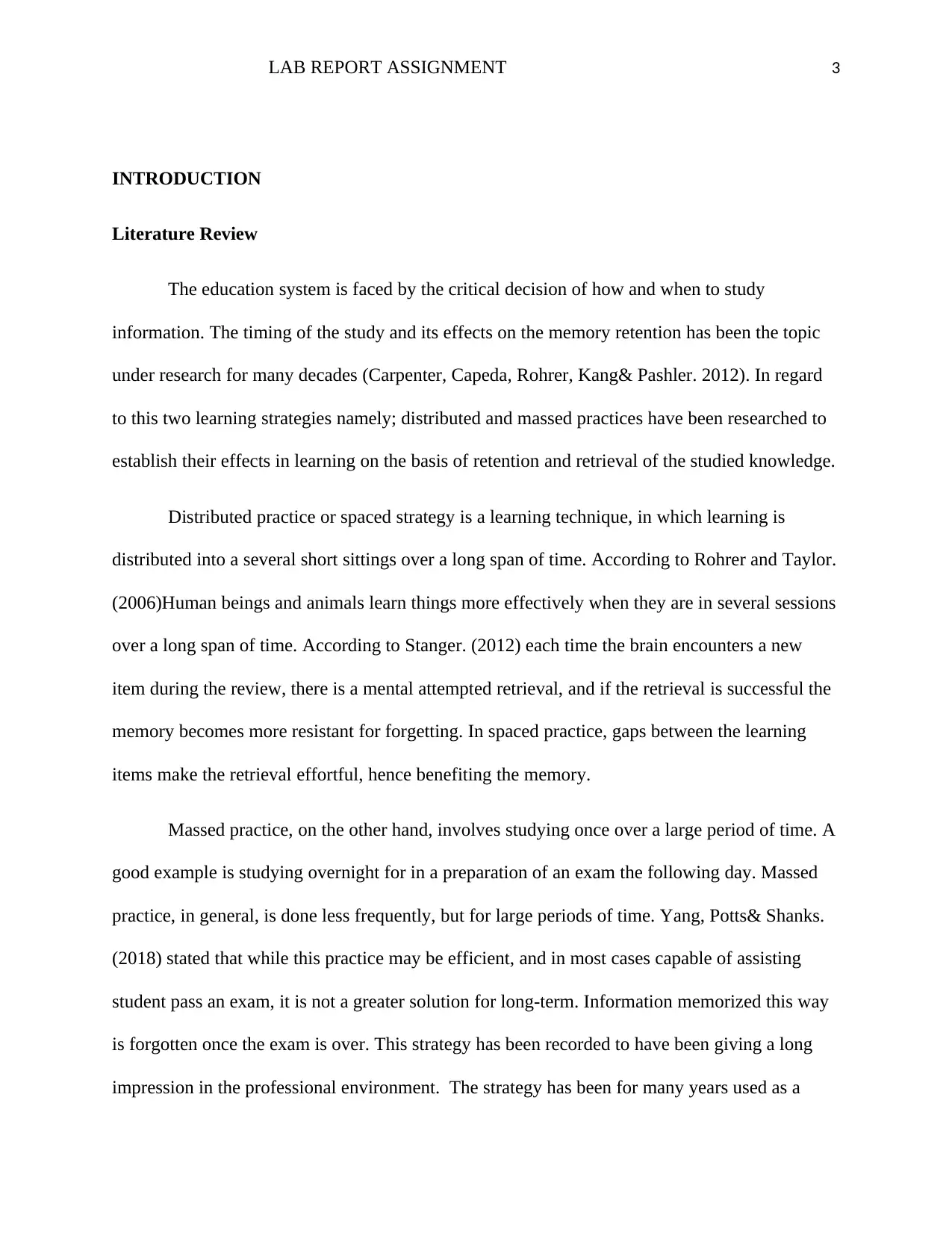
LAB REPORT ASSIGNMENT 3
INTRODUCTION
Literature Review
The education system is faced by the critical decision of how and when to study
information. The timing of the study and its effects on the memory retention has been the topic
under research for many decades (Carpenter, Capeda, Rohrer, Kang& Pashler. 2012). In regard
to this two learning strategies namely; distributed and massed practices have been researched to
establish their effects in learning on the basis of retention and retrieval of the studied knowledge.
Distributed practice or spaced strategy is a learning technique, in which learning is
distributed into a several short sittings over a long span of time. According to Rohrer and Taylor.
(2006)Human beings and animals learn things more effectively when they are in several sessions
over a long span of time. According to Stanger. (2012) each time the brain encounters a new
item during the review, there is a mental attempted retrieval, and if the retrieval is successful the
memory becomes more resistant for forgetting. In spaced practice, gaps between the learning
items make the retrieval effortful, hence benefiting the memory.
Massed practice, on the other hand, involves studying once over a large period of time. A
good example is studying overnight for in a preparation of an exam the following day. Massed
practice, in general, is done less frequently, but for large periods of time. Yang, Potts& Shanks.
(2018) stated that while this practice may be efficient, and in most cases capable of assisting
student pass an exam, it is not a greater solution for long-term. Information memorized this way
is forgotten once the exam is over. This strategy has been recorded to have been giving a long
impression in the professional environment. The strategy has been for many years used as a
INTRODUCTION
Literature Review
The education system is faced by the critical decision of how and when to study
information. The timing of the study and its effects on the memory retention has been the topic
under research for many decades (Carpenter, Capeda, Rohrer, Kang& Pashler. 2012). In regard
to this two learning strategies namely; distributed and massed practices have been researched to
establish their effects in learning on the basis of retention and retrieval of the studied knowledge.
Distributed practice or spaced strategy is a learning technique, in which learning is
distributed into a several short sittings over a long span of time. According to Rohrer and Taylor.
(2006)Human beings and animals learn things more effectively when they are in several sessions
over a long span of time. According to Stanger. (2012) each time the brain encounters a new
item during the review, there is a mental attempted retrieval, and if the retrieval is successful the
memory becomes more resistant for forgetting. In spaced practice, gaps between the learning
items make the retrieval effortful, hence benefiting the memory.
Massed practice, on the other hand, involves studying once over a large period of time. A
good example is studying overnight for in a preparation of an exam the following day. Massed
practice, in general, is done less frequently, but for large periods of time. Yang, Potts& Shanks.
(2018) stated that while this practice may be efficient, and in most cases capable of assisting
student pass an exam, it is not a greater solution for long-term. Information memorized this way
is forgotten once the exam is over. This strategy has been recorded to have been giving a long
impression in the professional environment. The strategy has been for many years used as a
⊘ This is a preview!⊘
Do you want full access?
Subscribe today to unlock all pages.

Trusted by 1+ million students worldwide
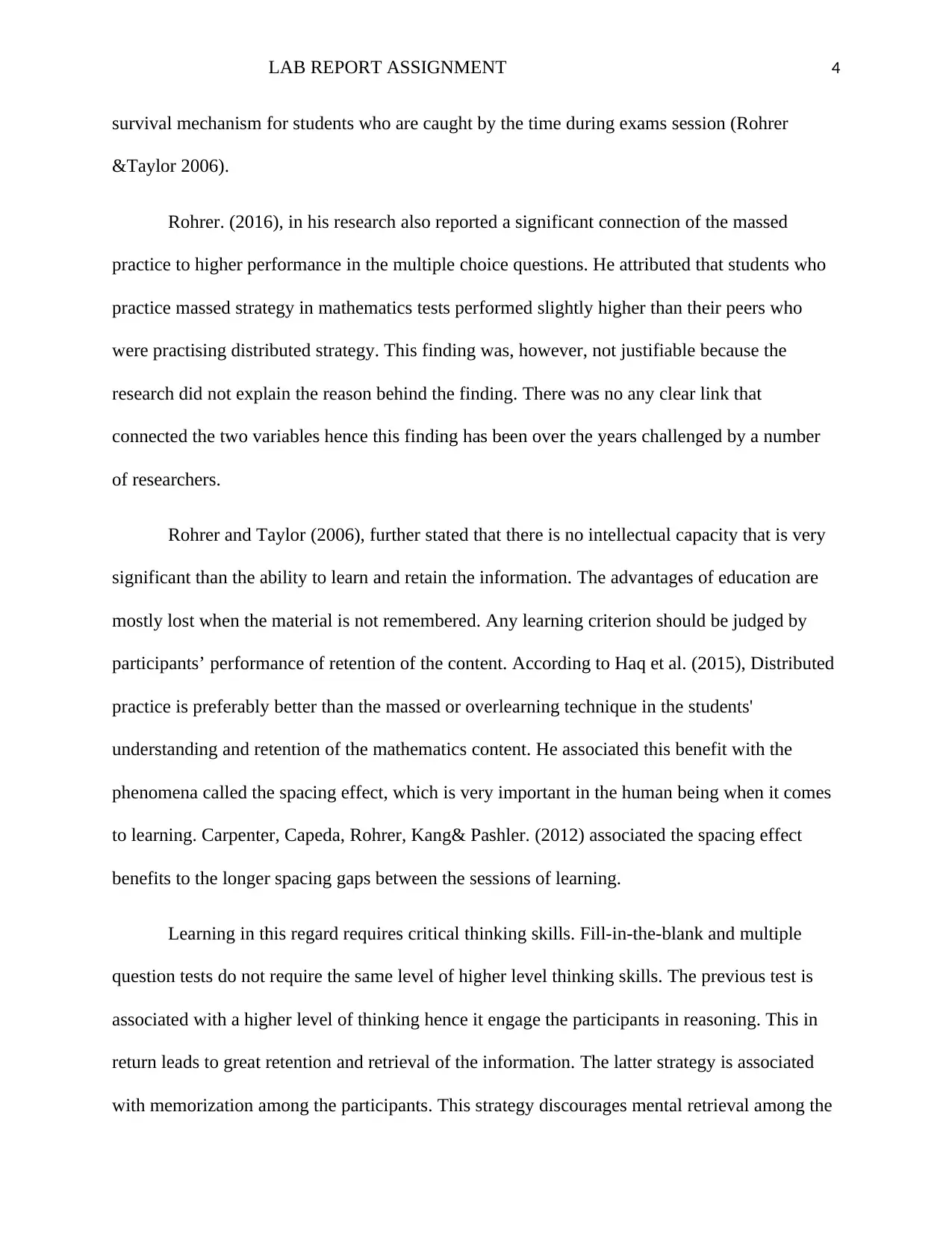
LAB REPORT ASSIGNMENT 4
survival mechanism for students who are caught by the time during exams session (Rohrer
&Taylor 2006).
Rohrer. (2016), in his research also reported a significant connection of the massed
practice to higher performance in the multiple choice questions. He attributed that students who
practice massed strategy in mathematics tests performed slightly higher than their peers who
were practising distributed strategy. This finding was, however, not justifiable because the
research did not explain the reason behind the finding. There was no any clear link that
connected the two variables hence this finding has been over the years challenged by a number
of researchers.
Rohrer and Taylor (2006), further stated that there is no intellectual capacity that is very
significant than the ability to learn and retain the information. The advantages of education are
mostly lost when the material is not remembered. Any learning criterion should be judged by
participants’ performance of retention of the content. According to Haq et al. (2015), Distributed
practice is preferably better than the massed or overlearning technique in the students'
understanding and retention of the mathematics content. He associated this benefit with the
phenomena called the spacing effect, which is very important in the human being when it comes
to learning. Carpenter, Capeda, Rohrer, Kang& Pashler. (2012) associated the spacing effect
benefits to the longer spacing gaps between the sessions of learning.
Learning in this regard requires critical thinking skills. Fill-in-the-blank and multiple
question tests do not require the same level of higher level thinking skills. The previous test is
associated with a higher level of thinking hence it engage the participants in reasoning. This in
return leads to great retention and retrieval of the information. The latter strategy is associated
with memorization among the participants. This strategy discourages mental retrieval among the
survival mechanism for students who are caught by the time during exams session (Rohrer
&Taylor 2006).
Rohrer. (2016), in his research also reported a significant connection of the massed
practice to higher performance in the multiple choice questions. He attributed that students who
practice massed strategy in mathematics tests performed slightly higher than their peers who
were practising distributed strategy. This finding was, however, not justifiable because the
research did not explain the reason behind the finding. There was no any clear link that
connected the two variables hence this finding has been over the years challenged by a number
of researchers.
Rohrer and Taylor (2006), further stated that there is no intellectual capacity that is very
significant than the ability to learn and retain the information. The advantages of education are
mostly lost when the material is not remembered. Any learning criterion should be judged by
participants’ performance of retention of the content. According to Haq et al. (2015), Distributed
practice is preferably better than the massed or overlearning technique in the students'
understanding and retention of the mathematics content. He associated this benefit with the
phenomena called the spacing effect, which is very important in the human being when it comes
to learning. Carpenter, Capeda, Rohrer, Kang& Pashler. (2012) associated the spacing effect
benefits to the longer spacing gaps between the sessions of learning.
Learning in this regard requires critical thinking skills. Fill-in-the-blank and multiple
question tests do not require the same level of higher level thinking skills. The previous test is
associated with a higher level of thinking hence it engage the participants in reasoning. This in
return leads to great retention and retrieval of the information. The latter strategy is associated
with memorization among the participants. This strategy discourages mental retrieval among the
Paraphrase This Document
Need a fresh take? Get an instant paraphrase of this document with our AI Paraphraser

LAB REPORT ASSIGNMENT 5
students hence less preferred by educationists (Schutte et al. 2015). Fill-in-the-blank test engages
the brain effectively leading to more capacity retention of the information among many students.
According to Rohrer (2015), mastering a huge body of knowledge or set of skills is a
challenge considering the limits on the human beings’ cognitive resources. This research
indicates that the final test performance improves with the number of repeated retrieval
opportunities and with an increase in the proportion of practice tests. The tests preferred here are
fill-in-the-blank rather than the multiple questions. Testing strategy affects holistically the
retention and retrieval outcomes among the students and should be well thought off (Haq &
Kodak). Retrieval rate among the two test is not affected by the groups of people such as gender
and age. Retrieval rate is strictly affected by the learning and testing strategies applied.
Hypotheses
1. It is hypothesized that the distributed practice will lead to better performance than massed
practice in both Fill-in-the-blank and multiple question tests.
2. It is predicted that massed practice will lead to a better performance in fill-in-the-blank
test compared to multiple questions test.
METHODS
Participants
Initially, this research included 274 psychology students who enrolled in an online
assessment. This was done purely on psychology research experience program of Swinburne.
The participants partook in the exchange for the credit for the course at this program
students hence less preferred by educationists (Schutte et al. 2015). Fill-in-the-blank test engages
the brain effectively leading to more capacity retention of the information among many students.
According to Rohrer (2015), mastering a huge body of knowledge or set of skills is a
challenge considering the limits on the human beings’ cognitive resources. This research
indicates that the final test performance improves with the number of repeated retrieval
opportunities and with an increase in the proportion of practice tests. The tests preferred here are
fill-in-the-blank rather than the multiple questions. Testing strategy affects holistically the
retention and retrieval outcomes among the students and should be well thought off (Haq &
Kodak). Retrieval rate among the two test is not affected by the groups of people such as gender
and age. Retrieval rate is strictly affected by the learning and testing strategies applied.
Hypotheses
1. It is hypothesized that the distributed practice will lead to better performance than massed
practice in both Fill-in-the-blank and multiple question tests.
2. It is predicted that massed practice will lead to a better performance in fill-in-the-blank
test compared to multiple questions test.
METHODS
Participants
Initially, this research included 274 psychology students who enrolled in an online
assessment. This was done purely on psychology research experience program of Swinburne.
The participants partook in the exchange for the credit for the course at this program
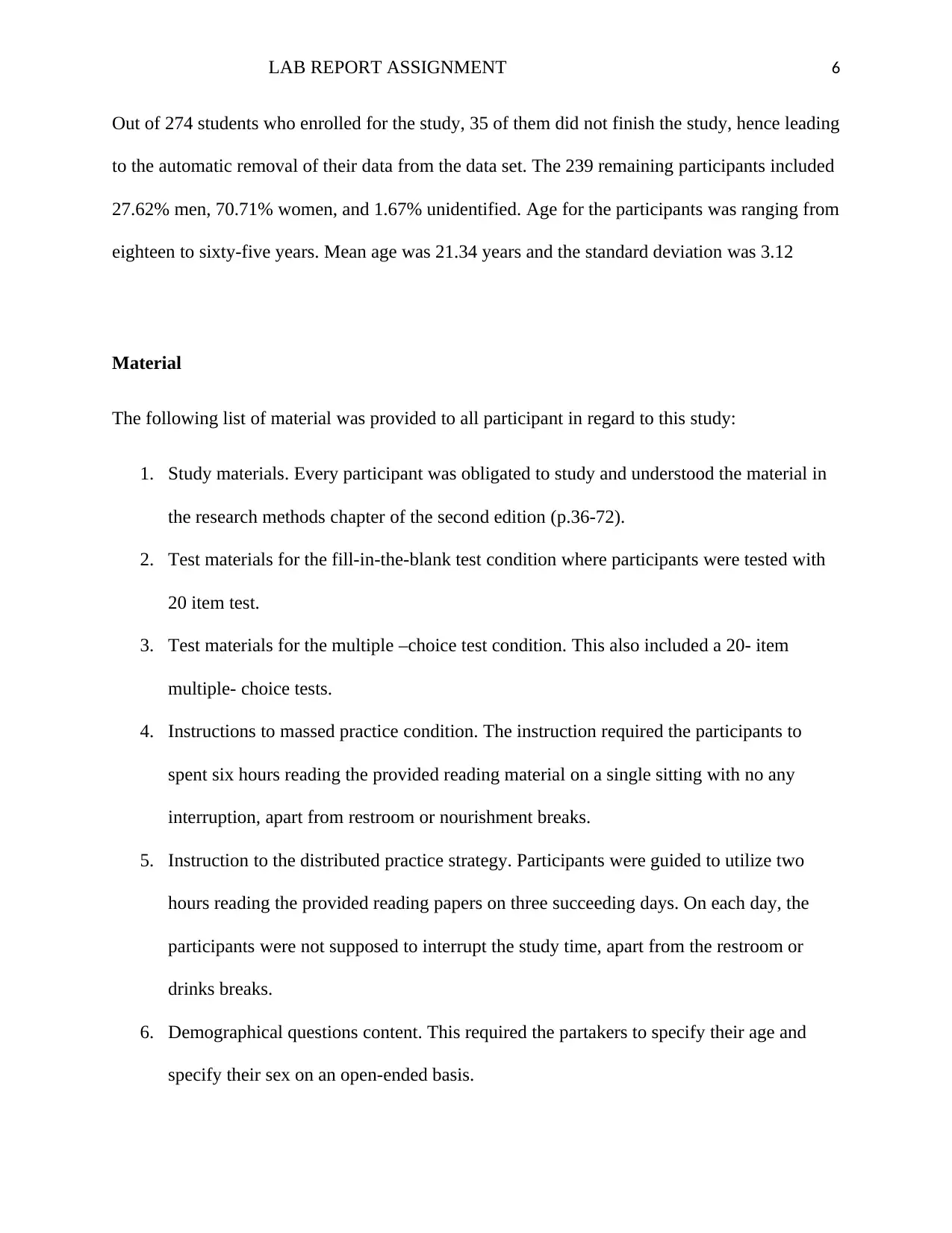
LAB REPORT ASSIGNMENT 6
Out of 274 students who enrolled for the study, 35 of them did not finish the study, hence leading
to the automatic removal of their data from the data set. The 239 remaining participants included
27.62% men, 70.71% women, and 1.67% unidentified. Age for the participants was ranging from
eighteen to sixty-five years. Mean age was 21.34 years and the standard deviation was 3.12
Material
The following list of material was provided to all participant in regard to this study:
1. Study materials. Every participant was obligated to study and understood the material in
the research methods chapter of the second edition (p.36-72).
2. Test materials for the fill-in-the-blank test condition where participants were tested with
20 item test.
3. Test materials for the multiple –choice test condition. This also included a 20- item
multiple- choice tests.
4. Instructions to massed practice condition. The instruction required the participants to
spent six hours reading the provided reading material on a single sitting with no any
interruption, apart from restroom or nourishment breaks.
5. Instruction to the distributed practice strategy. Participants were guided to utilize two
hours reading the provided reading papers on three succeeding days. On each day, the
participants were not supposed to interrupt the study time, apart from the restroom or
drinks breaks.
6. Demographical questions content. This required the partakers to specify their age and
specify their sex on an open-ended basis.
Out of 274 students who enrolled for the study, 35 of them did not finish the study, hence leading
to the automatic removal of their data from the data set. The 239 remaining participants included
27.62% men, 70.71% women, and 1.67% unidentified. Age for the participants was ranging from
eighteen to sixty-five years. Mean age was 21.34 years and the standard deviation was 3.12
Material
The following list of material was provided to all participant in regard to this study:
1. Study materials. Every participant was obligated to study and understood the material in
the research methods chapter of the second edition (p.36-72).
2. Test materials for the fill-in-the-blank test condition where participants were tested with
20 item test.
3. Test materials for the multiple –choice test condition. This also included a 20- item
multiple- choice tests.
4. Instructions to massed practice condition. The instruction required the participants to
spent six hours reading the provided reading material on a single sitting with no any
interruption, apart from restroom or nourishment breaks.
5. Instruction to the distributed practice strategy. Participants were guided to utilize two
hours reading the provided reading papers on three succeeding days. On each day, the
participants were not supposed to interrupt the study time, apart from the restroom or
drinks breaks.
6. Demographical questions content. This required the partakers to specify their age and
specify their sex on an open-ended basis.
⊘ This is a preview!⊘
Do you want full access?
Subscribe today to unlock all pages.

Trusted by 1+ million students worldwide
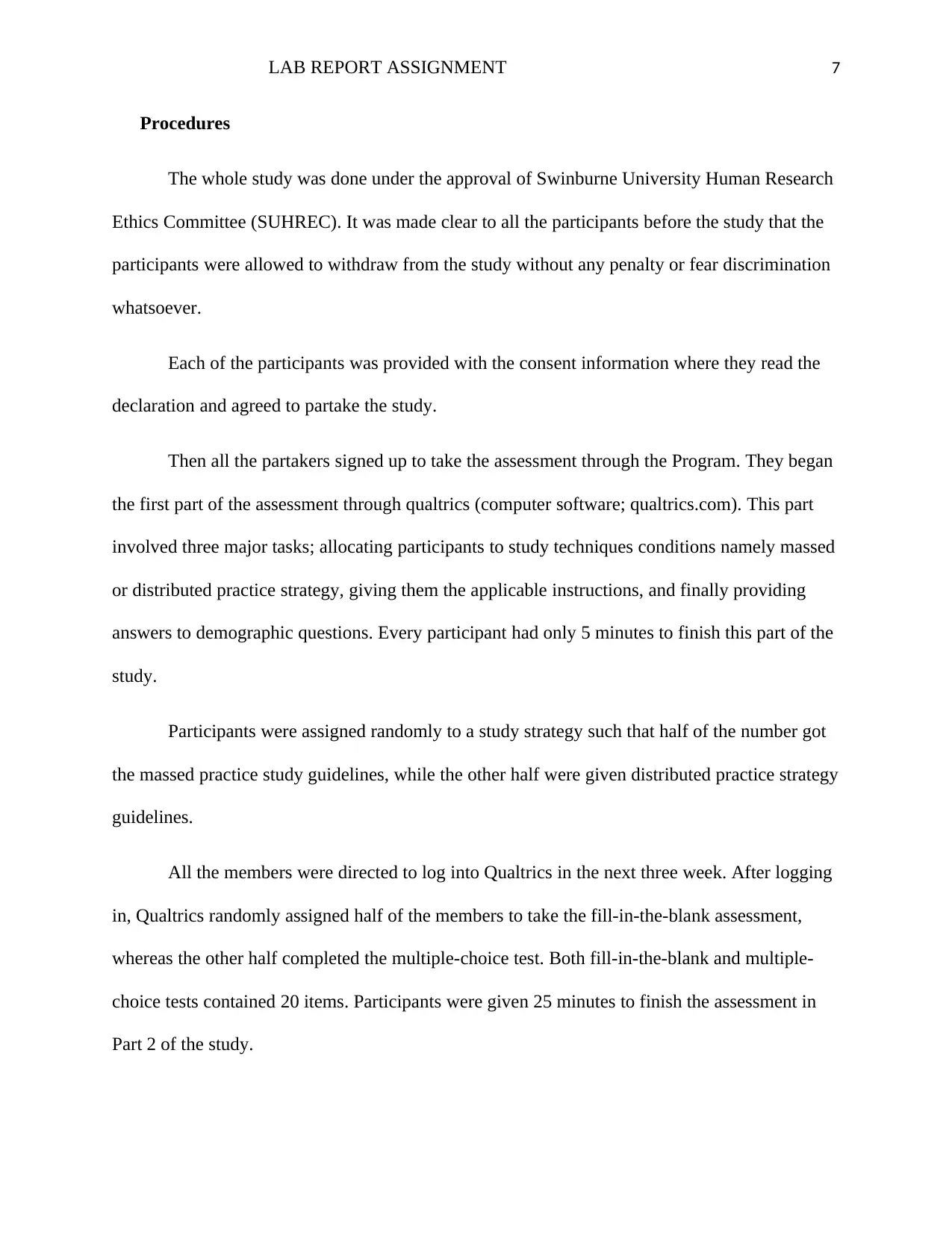
LAB REPORT ASSIGNMENT 7
Procedures
The whole study was done under the approval of Swinburne University Human Research
Ethics Committee (SUHREC). It was made clear to all the participants before the study that the
participants were allowed to withdraw from the study without any penalty or fear discrimination
whatsoever.
Each of the participants was provided with the consent information where they read the
declaration and agreed to partake the study.
Then all the partakers signed up to take the assessment through the Program. They began
the first part of the assessment through qualtrics (computer software; qualtrics.com). This part
involved three major tasks; allocating participants to study techniques conditions namely massed
or distributed practice strategy, giving them the applicable instructions, and finally providing
answers to demographic questions. Every participant had only 5 minutes to finish this part of the
study.
Participants were assigned randomly to a study strategy such that half of the number got
the massed practice study guidelines, while the other half were given distributed practice strategy
guidelines.
All the members were directed to log into Qualtrics in the next three week. After logging
in, Qualtrics randomly assigned half of the members to take the fill-in-the-blank assessment,
whereas the other half completed the multiple-choice test. Both fill-in-the-blank and multiple-
choice tests contained 20 items. Participants were given 25 minutes to finish the assessment in
Part 2 of the study.
Procedures
The whole study was done under the approval of Swinburne University Human Research
Ethics Committee (SUHREC). It was made clear to all the participants before the study that the
participants were allowed to withdraw from the study without any penalty or fear discrimination
whatsoever.
Each of the participants was provided with the consent information where they read the
declaration and agreed to partake the study.
Then all the partakers signed up to take the assessment through the Program. They began
the first part of the assessment through qualtrics (computer software; qualtrics.com). This part
involved three major tasks; allocating participants to study techniques conditions namely massed
or distributed practice strategy, giving them the applicable instructions, and finally providing
answers to demographic questions. Every participant had only 5 minutes to finish this part of the
study.
Participants were assigned randomly to a study strategy such that half of the number got
the massed practice study guidelines, while the other half were given distributed practice strategy
guidelines.
All the members were directed to log into Qualtrics in the next three week. After logging
in, Qualtrics randomly assigned half of the members to take the fill-in-the-blank assessment,
whereas the other half completed the multiple-choice test. Both fill-in-the-blank and multiple-
choice tests contained 20 items. Participants were given 25 minutes to finish the assessment in
Part 2 of the study.
Paraphrase This Document
Need a fresh take? Get an instant paraphrase of this document with our AI Paraphraser
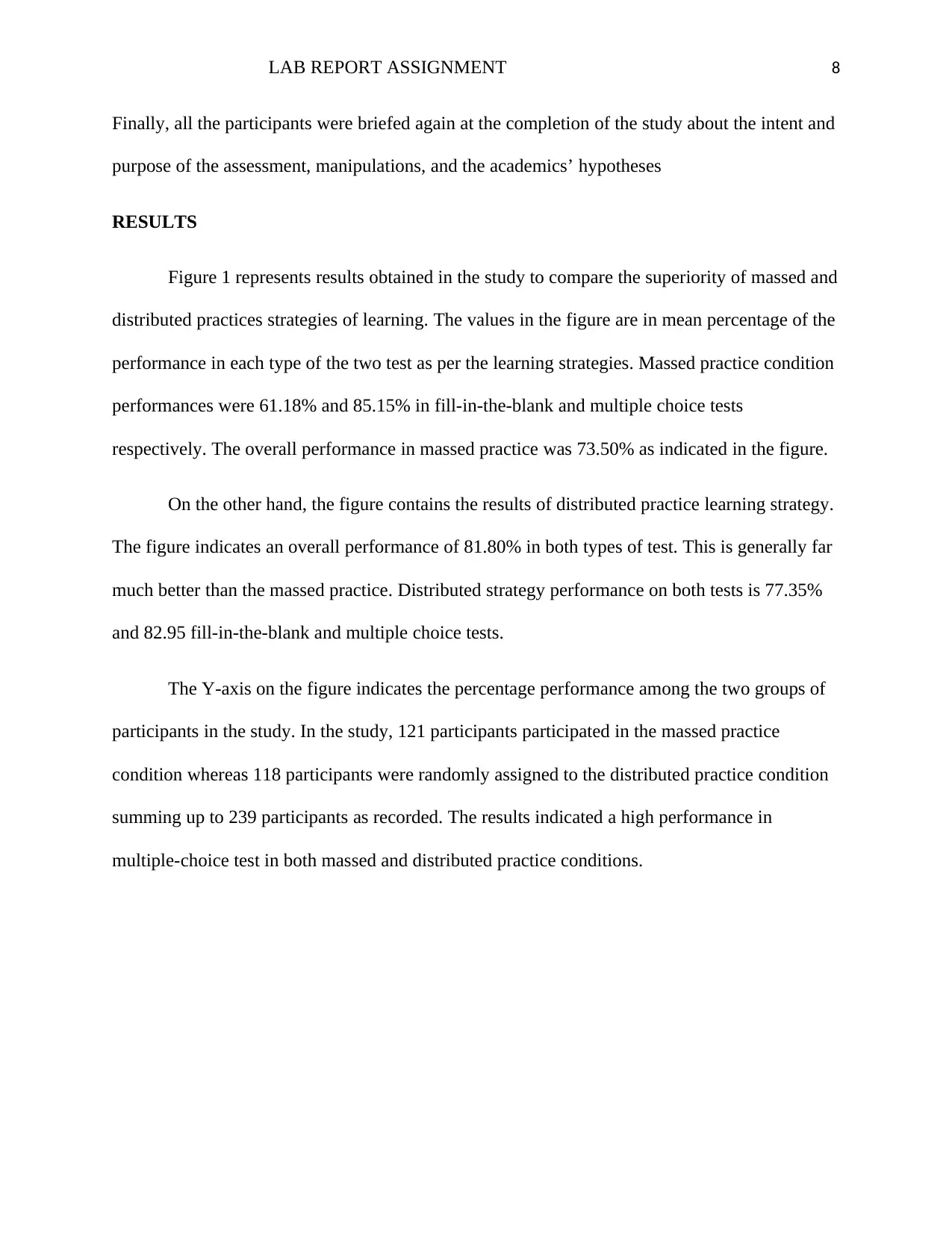
LAB REPORT ASSIGNMENT 8
Finally, all the participants were briefed again at the completion of the study about the intent and
purpose of the assessment, manipulations, and the academics’ hypotheses
RESULTS
Figure 1 represents results obtained in the study to compare the superiority of massed and
distributed practices strategies of learning. The values in the figure are in mean percentage of the
performance in each type of the two test as per the learning strategies. Massed practice condition
performances were 61.18% and 85.15% in fill-in-the-blank and multiple choice tests
respectively. The overall performance in massed practice was 73.50% as indicated in the figure.
On the other hand, the figure contains the results of distributed practice learning strategy.
The figure indicates an overall performance of 81.80% in both types of test. This is generally far
much better than the massed practice. Distributed strategy performance on both tests is 77.35%
and 82.95 fill-in-the-blank and multiple choice tests.
The Y-axis on the figure indicates the percentage performance among the two groups of
participants in the study. In the study, 121 participants participated in the massed practice
condition whereas 118 participants were randomly assigned to the distributed practice condition
summing up to 239 participants as recorded. The results indicated a high performance in
multiple-choice test in both massed and distributed practice conditions.
Finally, all the participants were briefed again at the completion of the study about the intent and
purpose of the assessment, manipulations, and the academics’ hypotheses
RESULTS
Figure 1 represents results obtained in the study to compare the superiority of massed and
distributed practices strategies of learning. The values in the figure are in mean percentage of the
performance in each type of the two test as per the learning strategies. Massed practice condition
performances were 61.18% and 85.15% in fill-in-the-blank and multiple choice tests
respectively. The overall performance in massed practice was 73.50% as indicated in the figure.
On the other hand, the figure contains the results of distributed practice learning strategy.
The figure indicates an overall performance of 81.80% in both types of test. This is generally far
much better than the massed practice. Distributed strategy performance on both tests is 77.35%
and 82.95 fill-in-the-blank and multiple choice tests.
The Y-axis on the figure indicates the percentage performance among the two groups of
participants in the study. In the study, 121 participants participated in the massed practice
condition whereas 118 participants were randomly assigned to the distributed practice condition
summing up to 239 participants as recorded. The results indicated a high performance in
multiple-choice test in both massed and distributed practice conditions.
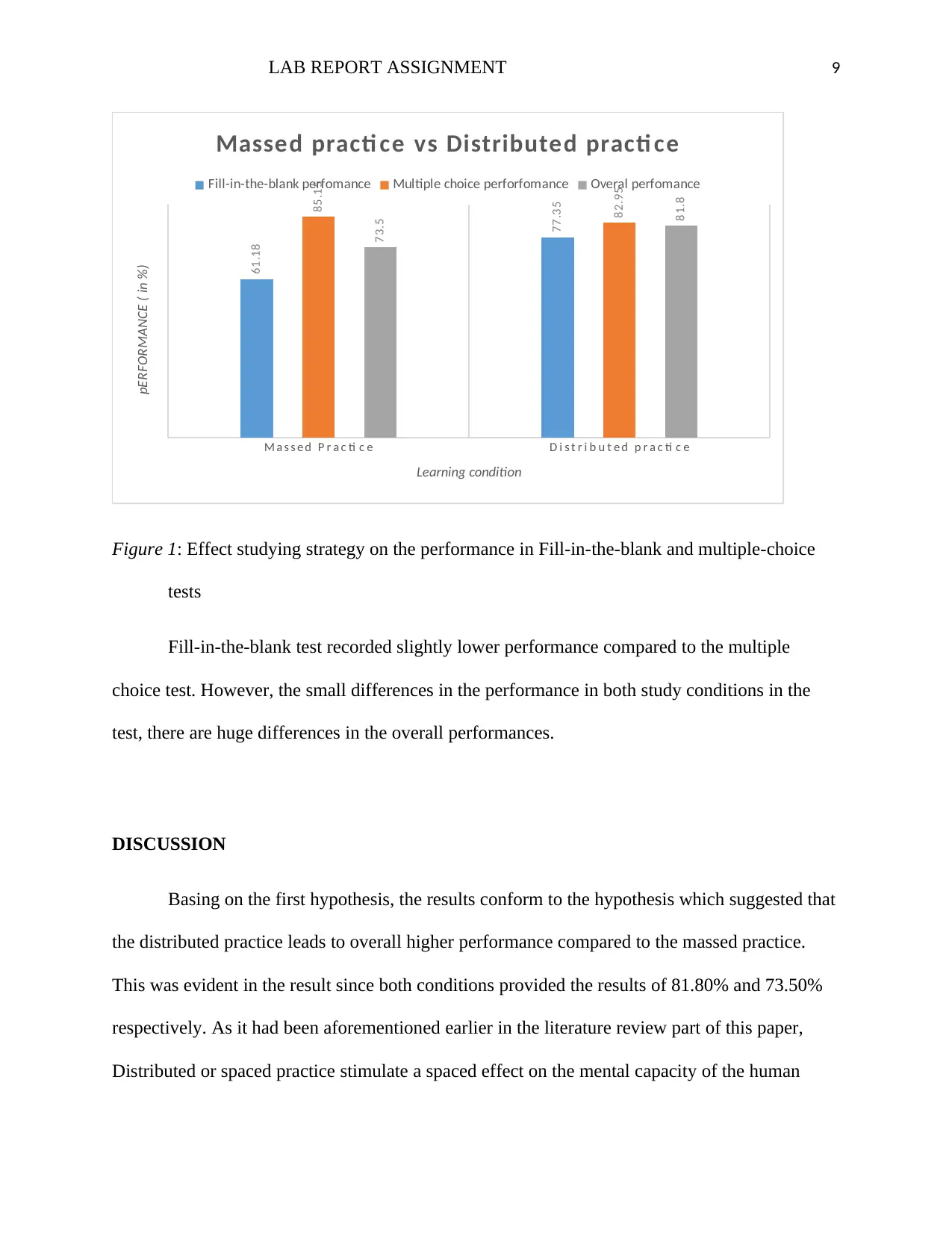
LAB REPORT ASSIGNMENT 9
M a s s e d P r a c ti c e D i s t r i b u t e d p r a c ti c e
61.18
77.35
85.15
82.95
73.5
81.8
Massed practi ce vs Distributed practi ce
Fill-in-the-blank perfomance Multiple choice perforfomance Overal perfomance
Learning condition
pERFORMANCE ( in %)
Figure 1: Effect studying strategy on the performance in Fill-in-the-blank and multiple-choice
tests
Fill-in-the-blank test recorded slightly lower performance compared to the multiple
choice test. However, the small differences in the performance in both study conditions in the
test, there are huge differences in the overall performances.
DISCUSSION
Basing on the first hypothesis, the results conform to the hypothesis which suggested that
the distributed practice leads to overall higher performance compared to the massed practice.
This was evident in the result since both conditions provided the results of 81.80% and 73.50%
respectively. As it had been aforementioned earlier in the literature review part of this paper,
Distributed or spaced practice stimulate a spaced effect on the mental capacity of the human
M a s s e d P r a c ti c e D i s t r i b u t e d p r a c ti c e
61.18
77.35
85.15
82.95
73.5
81.8
Massed practi ce vs Distributed practi ce
Fill-in-the-blank perfomance Multiple choice perforfomance Overal perfomance
Learning condition
pERFORMANCE ( in %)
Figure 1: Effect studying strategy on the performance in Fill-in-the-blank and multiple-choice
tests
Fill-in-the-blank test recorded slightly lower performance compared to the multiple
choice test. However, the small differences in the performance in both study conditions in the
test, there are huge differences in the overall performances.
DISCUSSION
Basing on the first hypothesis, the results conform to the hypothesis which suggested that
the distributed practice leads to overall higher performance compared to the massed practice.
This was evident in the result since both conditions provided the results of 81.80% and 73.50%
respectively. As it had been aforementioned earlier in the literature review part of this paper,
Distributed or spaced practice stimulate a spaced effect on the mental capacity of the human
⊘ This is a preview!⊘
Do you want full access?
Subscribe today to unlock all pages.

Trusted by 1+ million students worldwide
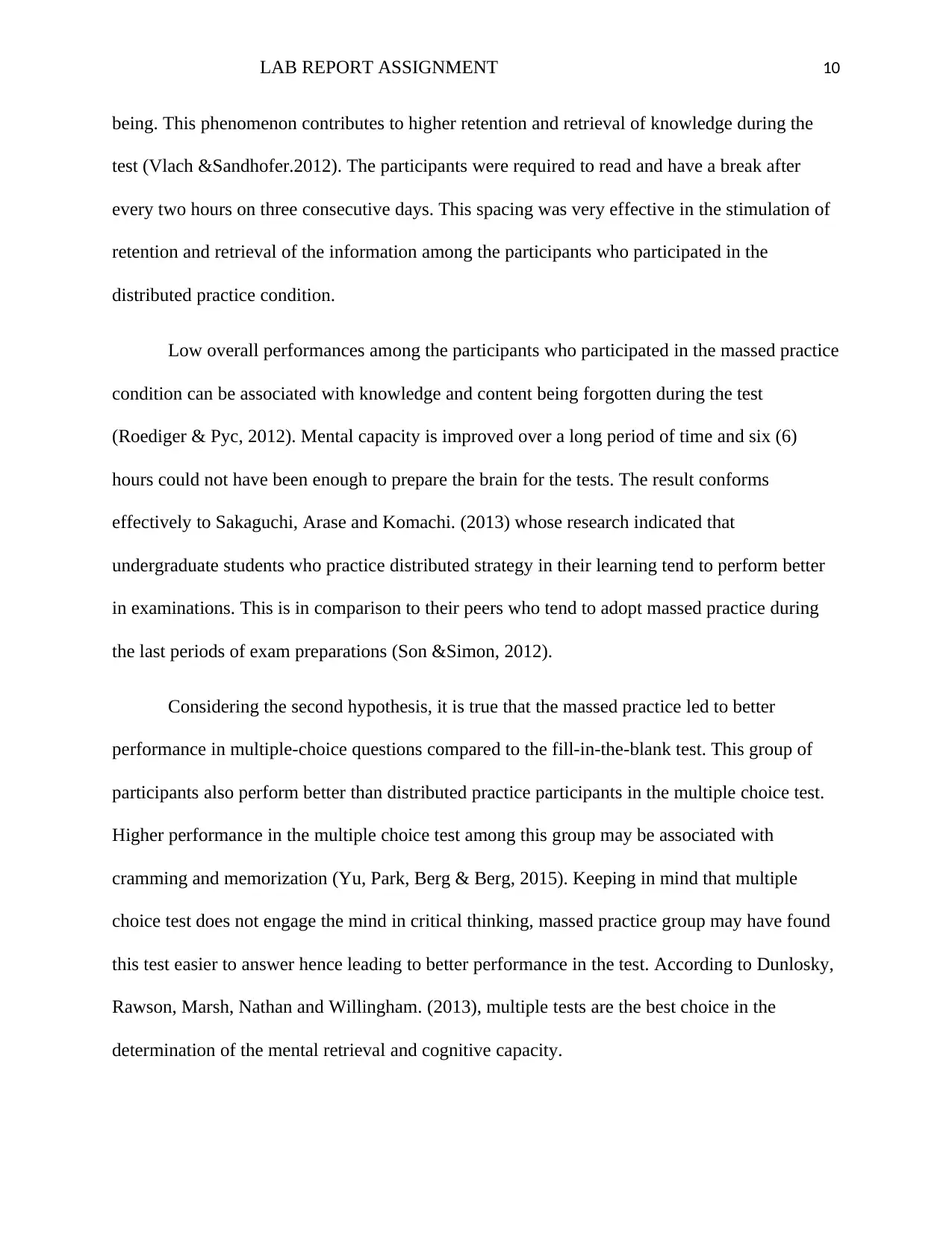
LAB REPORT ASSIGNMENT 10
being. This phenomenon contributes to higher retention and retrieval of knowledge during the
test (Vlach &Sandhofer.2012). The participants were required to read and have a break after
every two hours on three consecutive days. This spacing was very effective in the stimulation of
retention and retrieval of the information among the participants who participated in the
distributed practice condition.
Low overall performances among the participants who participated in the massed practice
condition can be associated with knowledge and content being forgotten during the test
(Roediger & Pyc, 2012). Mental capacity is improved over a long period of time and six (6)
hours could not have been enough to prepare the brain for the tests. The result conforms
effectively to Sakaguchi, Arase and Komachi. (2013) whose research indicated that
undergraduate students who practice distributed strategy in their learning tend to perform better
in examinations. This is in comparison to their peers who tend to adopt massed practice during
the last periods of exam preparations (Son &Simon, 2012).
Considering the second hypothesis, it is true that the massed practice led to better
performance in multiple-choice questions compared to the fill-in-the-blank test. This group of
participants also perform better than distributed practice participants in the multiple choice test.
Higher performance in the multiple choice test among this group may be associated with
cramming and memorization (Yu, Park, Berg & Berg, 2015). Keeping in mind that multiple
choice test does not engage the mind in critical thinking, massed practice group may have found
this test easier to answer hence leading to better performance in the test. According to Dunlosky,
Rawson, Marsh, Nathan and Willingham. (2013), multiple tests are the best choice in the
determination of the mental retrieval and cognitive capacity.
being. This phenomenon contributes to higher retention and retrieval of knowledge during the
test (Vlach &Sandhofer.2012). The participants were required to read and have a break after
every two hours on three consecutive days. This spacing was very effective in the stimulation of
retention and retrieval of the information among the participants who participated in the
distributed practice condition.
Low overall performances among the participants who participated in the massed practice
condition can be associated with knowledge and content being forgotten during the test
(Roediger & Pyc, 2012). Mental capacity is improved over a long period of time and six (6)
hours could not have been enough to prepare the brain for the tests. The result conforms
effectively to Sakaguchi, Arase and Komachi. (2013) whose research indicated that
undergraduate students who practice distributed strategy in their learning tend to perform better
in examinations. This is in comparison to their peers who tend to adopt massed practice during
the last periods of exam preparations (Son &Simon, 2012).
Considering the second hypothesis, it is true that the massed practice led to better
performance in multiple-choice questions compared to the fill-in-the-blank test. This group of
participants also perform better than distributed practice participants in the multiple choice test.
Higher performance in the multiple choice test among this group may be associated with
cramming and memorization (Yu, Park, Berg & Berg, 2015). Keeping in mind that multiple
choice test does not engage the mind in critical thinking, massed practice group may have found
this test easier to answer hence leading to better performance in the test. According to Dunlosky,
Rawson, Marsh, Nathan and Willingham. (2013), multiple tests are the best choice in the
determination of the mental retrieval and cognitive capacity.
Paraphrase This Document
Need a fresh take? Get an instant paraphrase of this document with our AI Paraphraser
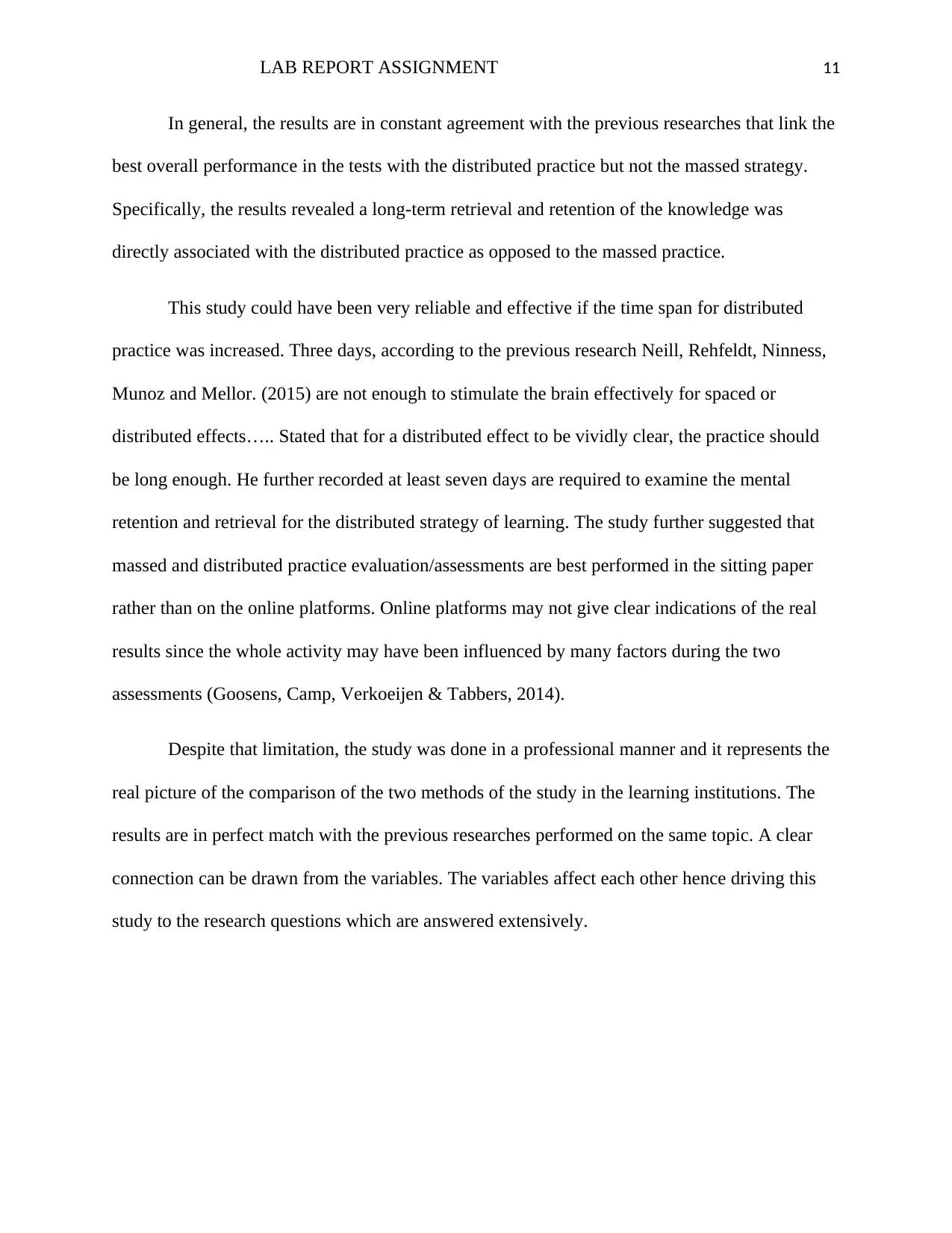
LAB REPORT ASSIGNMENT 11
In general, the results are in constant agreement with the previous researches that link the
best overall performance in the tests with the distributed practice but not the massed strategy.
Specifically, the results revealed a long-term retrieval and retention of the knowledge was
directly associated with the distributed practice as opposed to the massed practice.
This study could have been very reliable and effective if the time span for distributed
practice was increased. Three days, according to the previous research Neill, Rehfeldt, Ninness,
Munoz and Mellor. (2015) are not enough to stimulate the brain effectively for spaced or
distributed effects….. Stated that for a distributed effect to be vividly clear, the practice should
be long enough. He further recorded at least seven days are required to examine the mental
retention and retrieval for the distributed strategy of learning. The study further suggested that
massed and distributed practice evaluation/assessments are best performed in the sitting paper
rather than on the online platforms. Online platforms may not give clear indications of the real
results since the whole activity may have been influenced by many factors during the two
assessments (Goosens, Camp, Verkoeijen & Tabbers, 2014).
Despite that limitation, the study was done in a professional manner and it represents the
real picture of the comparison of the two methods of the study in the learning institutions. The
results are in perfect match with the previous researches performed on the same topic. A clear
connection can be drawn from the variables. The variables affect each other hence driving this
study to the research questions which are answered extensively.
In general, the results are in constant agreement with the previous researches that link the
best overall performance in the tests with the distributed practice but not the massed strategy.
Specifically, the results revealed a long-term retrieval and retention of the knowledge was
directly associated with the distributed practice as opposed to the massed practice.
This study could have been very reliable and effective if the time span for distributed
practice was increased. Three days, according to the previous research Neill, Rehfeldt, Ninness,
Munoz and Mellor. (2015) are not enough to stimulate the brain effectively for spaced or
distributed effects….. Stated that for a distributed effect to be vividly clear, the practice should
be long enough. He further recorded at least seven days are required to examine the mental
retention and retrieval for the distributed strategy of learning. The study further suggested that
massed and distributed practice evaluation/assessments are best performed in the sitting paper
rather than on the online platforms. Online platforms may not give clear indications of the real
results since the whole activity may have been influenced by many factors during the two
assessments (Goosens, Camp, Verkoeijen & Tabbers, 2014).
Despite that limitation, the study was done in a professional manner and it represents the
real picture of the comparison of the two methods of the study in the learning institutions. The
results are in perfect match with the previous researches performed on the same topic. A clear
connection can be drawn from the variables. The variables affect each other hence driving this
study to the research questions which are answered extensively.
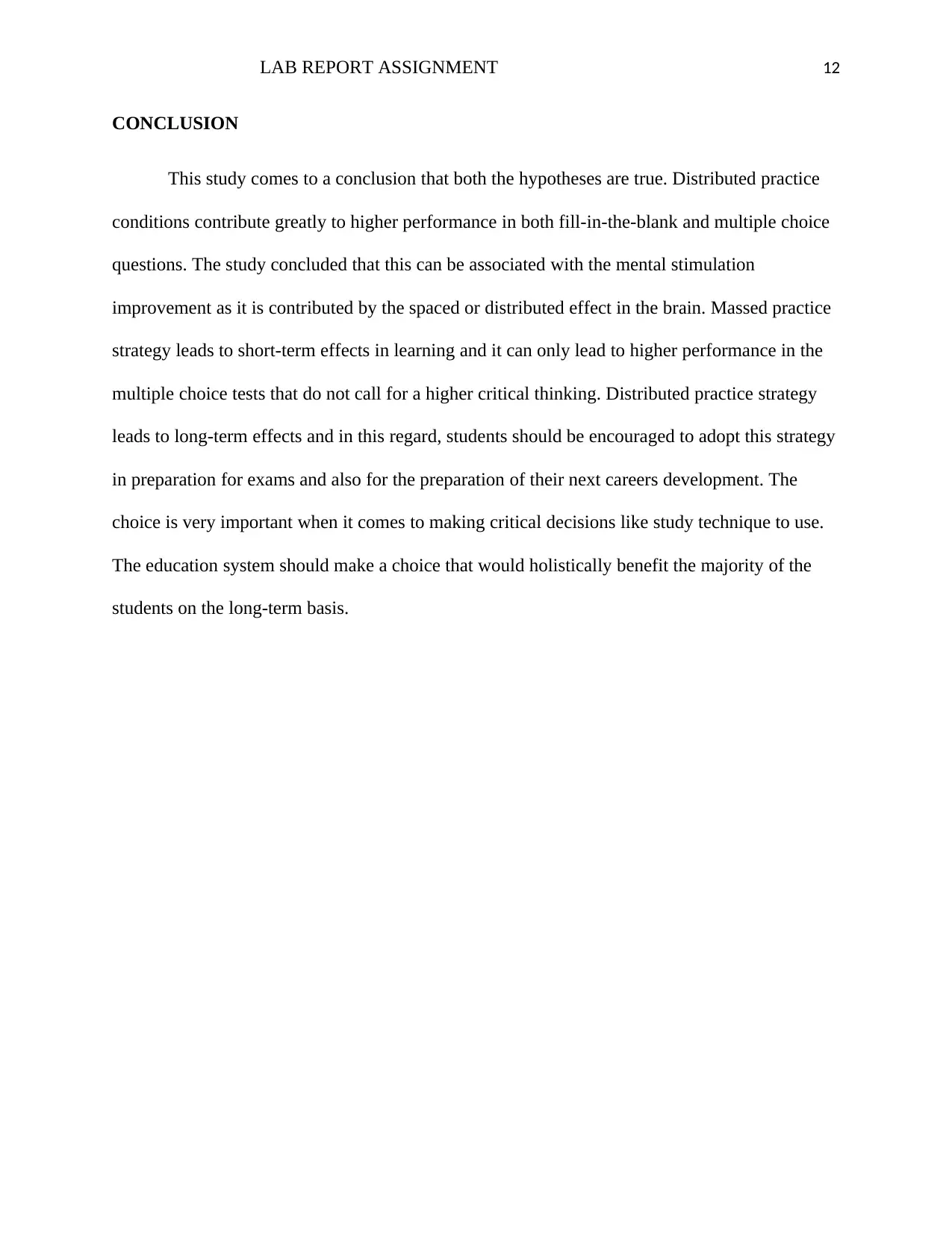
LAB REPORT ASSIGNMENT 12
CONCLUSION
This study comes to a conclusion that both the hypotheses are true. Distributed practice
conditions contribute greatly to higher performance in both fill-in-the-blank and multiple choice
questions. The study concluded that this can be associated with the mental stimulation
improvement as it is contributed by the spaced or distributed effect in the brain. Massed practice
strategy leads to short-term effects in learning and it can only lead to higher performance in the
multiple choice tests that do not call for a higher critical thinking. Distributed practice strategy
leads to long-term effects and in this regard, students should be encouraged to adopt this strategy
in preparation for exams and also for the preparation of their next careers development. The
choice is very important when it comes to making critical decisions like study technique to use.
The education system should make a choice that would holistically benefit the majority of the
students on the long-term basis.
CONCLUSION
This study comes to a conclusion that both the hypotheses are true. Distributed practice
conditions contribute greatly to higher performance in both fill-in-the-blank and multiple choice
questions. The study concluded that this can be associated with the mental stimulation
improvement as it is contributed by the spaced or distributed effect in the brain. Massed practice
strategy leads to short-term effects in learning and it can only lead to higher performance in the
multiple choice tests that do not call for a higher critical thinking. Distributed practice strategy
leads to long-term effects and in this regard, students should be encouraged to adopt this strategy
in preparation for exams and also for the preparation of their next careers development. The
choice is very important when it comes to making critical decisions like study technique to use.
The education system should make a choice that would holistically benefit the majority of the
students on the long-term basis.
⊘ This is a preview!⊘
Do you want full access?
Subscribe today to unlock all pages.

Trusted by 1+ million students worldwide
1 out of 15
Related Documents
Your All-in-One AI-Powered Toolkit for Academic Success.
+13062052269
info@desklib.com
Available 24*7 on WhatsApp / Email
![[object Object]](/_next/static/media/star-bottom.7253800d.svg)
Unlock your academic potential
Copyright © 2020–2025 A2Z Services. All Rights Reserved. Developed and managed by ZUCOL.





